Virtual Reality & the Vergence-Accommodation Conflict
What is the Vergence-Accommodation Conflict?
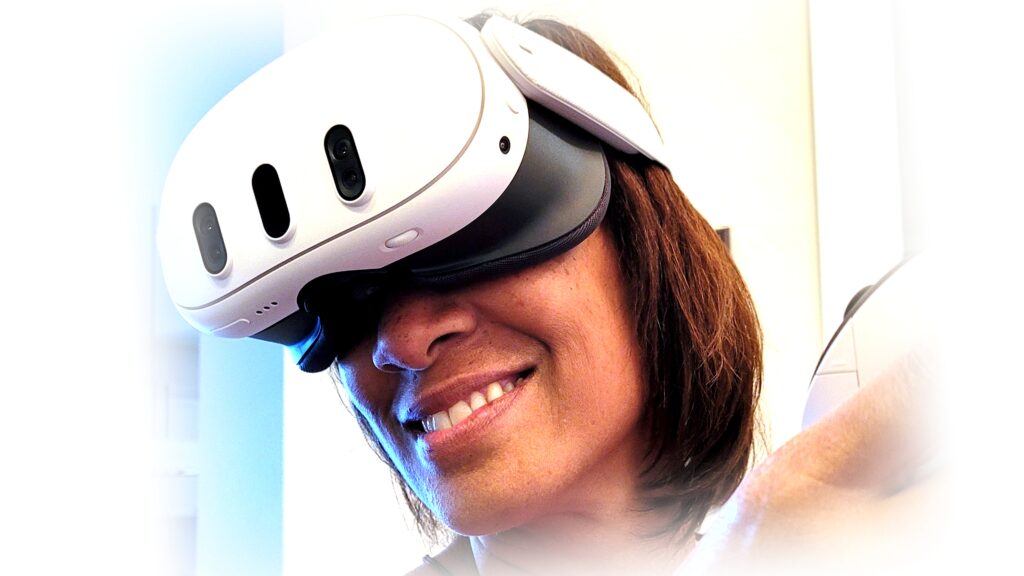
To understand the Vergence-Accommodation Conflict in virtual reality (VR) headsets, we must first understand how Vergence and Accommodation are “not in conflict” in the real world.
In the real world, our focus system is linked in the brain in a response called the Accommodation Reflex. As an object gets closer, our eyes accommodate (an eye can focus like a camera must focus as an object gets closer to keep the image clear), converge (each eye must turn inward to keep fixation on the object- the eye’s lines of sight cross paths), and our pupils get smaller to maintain crisp binocular vision. When an object moves away, the opposite happens… Our eyes relax accommodation, diverge (they uncross paths), and the pupil gets larger.
The Vergence-Accommodation Conflict in VR presents an experience that unlinks vergence from accommodation, and, therefore, does not fully mimic a real world experience. This dissociation can be one of many factors that can contribute to “motion sickness” while immersed in the virtual world. Technology is advancing to reduce this effect. To fully understand this disconnect, various factors of the accommodative reflex need to be understood.
What is Vergence of the Eyes?
To understand vergence, imagine that you are looking at the evening star on the horizon. When you are looking very far away, essentially, the lines of sight for the eyes are parallel, meaning there is no vergence, the lines of sight do NOT cross. When you are looking at something closer to you, the lines of sight are crossing at the point of fixation. This crossing of the lines of sight is termed “vergence”. One of the verb tense forms of the word “verge” means, “to move in some direction.” Vergence is further divided into convergence and divergence.
What is Convergence of the Eyes?
Imagine once again that you look from the evening star on the horizon to a pencil held three feet in front of your nose, so that your eyes are each looking at the No.2 printed near the eraser. Each eye would have to turn inward toward your nose (so opposite inward directions) to align gaze upon the No.2. This coordinated inward turning of the eyes is called “convergence”. The prefix “con-” means “together,” so the lines of sight move in a together direction. If you continue to bring the pencil closer, say up to one foot in front of your nose, each of your eyes would converge even more to maintain a line of sight on that No.2.
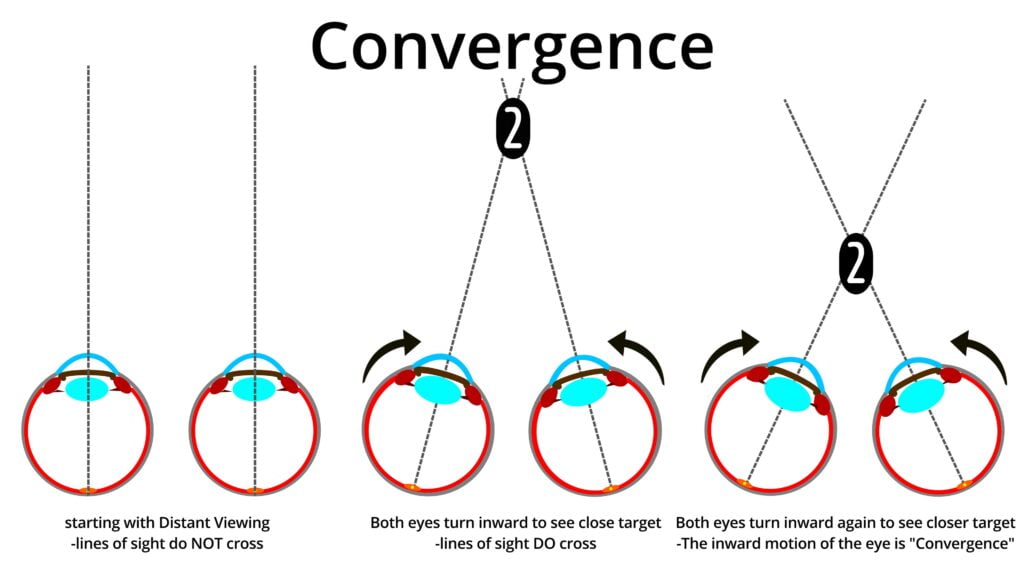
What is Divergence of the Eyes?
If you are looking at the No.2 printed near the eraser of a pencil at one foot away from your nose, each eye would be pointed inward toward the nose so that each eye could align on the same fixation point, the No.2 print. If you move the pencil away to three feet, then each eye would have to move outward from the nose (so opposite outward directions) so that the lines of sight would become less crossed. When the lines become less crossed, it is termed “divergence” The prefix “di-” means “apart,” so the crossing of lines of sight are moving in an apart direction.
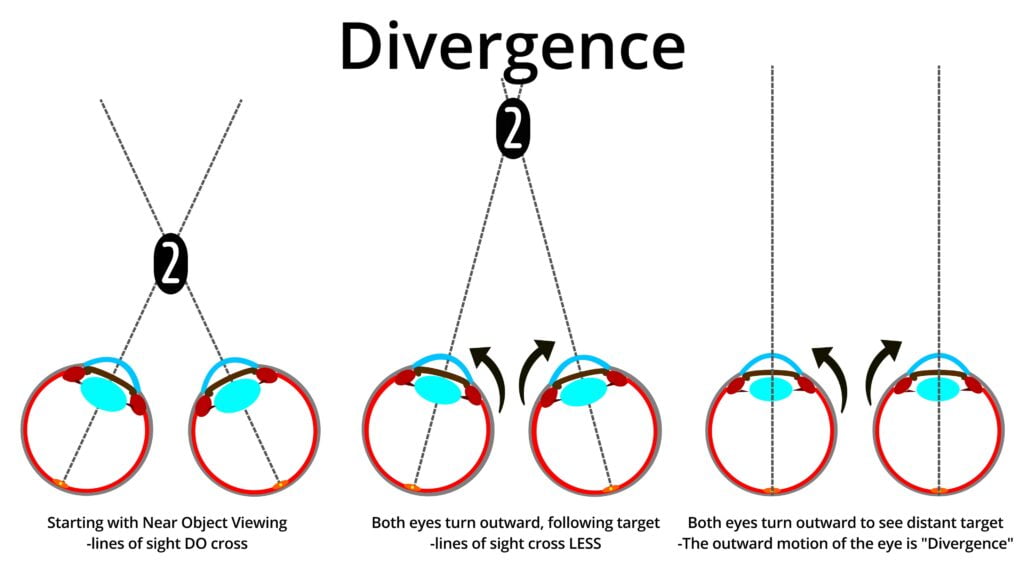
What is a Monocular Image?
Human pupils are separated by a distance of about 6 centimeters. This separation provides a slightly different angle of view for each eye. This angle viewing difference (termed “parallax”) means that each eye has its own unique perception of the point of fixation. The image that each eye receives individually is considered a monocular image. The prefix “mono-” means “one”, and the term “ocular” means “relating to the eye”. Therefore, monocular means “one eye”.
What is a Binocular Image?
When we view the world, most of us have the luxury of using two eyes in coordination, but we do not see the world as two separate monocular images. No. Instead, our brain utilizes the parallax (different angles of viewing the same object) and combines those two monocular images into one binocular image. The prefix “bi-” means two, so “binocular means “two eyes”. The brain splices the two monocular images received from each eye into ONE SINGLE binocular image. Therefore, we ultimately perceive only one binocular image, even though it has been produced by two separate monocular images.
Many times in my exam room, a patient will cover each eye individually and read the eye chart, only to discover in the end, “Oh, I can see the letters much better with both eyes,” because it’s true. Two eyes are better than one.
What is Depth Perception and Stereopsis?
When both eyes are being used together for seeing the same object, even though from different angles, the brain can combine the two images by activating more neuro cells for greater interpretation of the image. But we do not just have greater acuity with this teamwork with our eyes, we also gain depth perception from the parallax effect. Our most fine tuned interpretation of depth perception is termed “stereopsis.” The prefix “stereo-” means “three-dimensional” and “opsis” refers to sight. Therefore, binocular viewing serves to provide three-dimensional sight.
What is the Accommodation (Focus)?
In order for each eye to see clearly, light from a distant object must pass through the cornea, pupil, and lens, and ultimately focus on the fovea in the back of the eye. Since light is divergent in nature, the closer that the object is moved toward the eye, the further the point of focus shifts behind the fovea. To maintain a precise focus on the fovea, the eye must accommodate for this focal shift. To achieve this, ciliary muscles that surround the crystalline lens behind the pupil flex, which causes the lens to morph into a rounder shape and change in optical power. The power change to the lens shifts the point of focus back onto the fovea. If the object moves away, and the point of focus shifts in front of the fovea, causing the ciliary muscles to relax, and therefore the lens to flatten and reduce in power. Less power pushes the focus point back onto the fovea again. This maintenance of focus is termed “accommodation”. Often, the term “accommodation” is used interchangeably with the term “focus”.

How is Accommodation (Focus) Power Measured?
When an object moves closer to a camera, the camera has to adjust its focus to maintain a clear image. The eye works the same way. If an object moves closer to the eye, the eye has to alter its power to maintain focus. It maintains focus by altering the lens shape. When the lens changes shape, its power changes.
The power change in the lens necessary to move the point of focus in the eye is measured in diopters. For example, in the real world, when a distant light sends parallel light into a perfectly focused eye, the crystalline lens is in its flattest form and light focuses perfectly on the fovea. The lens does not have to change its power, because light focuses where it’s supposed to focus for clear vision, the fovea. The amount of dioptric power necessary to maintain focus with the accommodation of the lens as the object moves closer is determined by this simple formula…

How many Diopters Can an Eye Accommodate (Focus)?
The maximum ability for a lens to accommodate is referred to as the amplitude of accommodation. This ability does not designate a comfortable level of accommodation, just the maximum capability under best conditions before clarity is lost. Here are approximate maximum length and associated dioptric power at different ages:
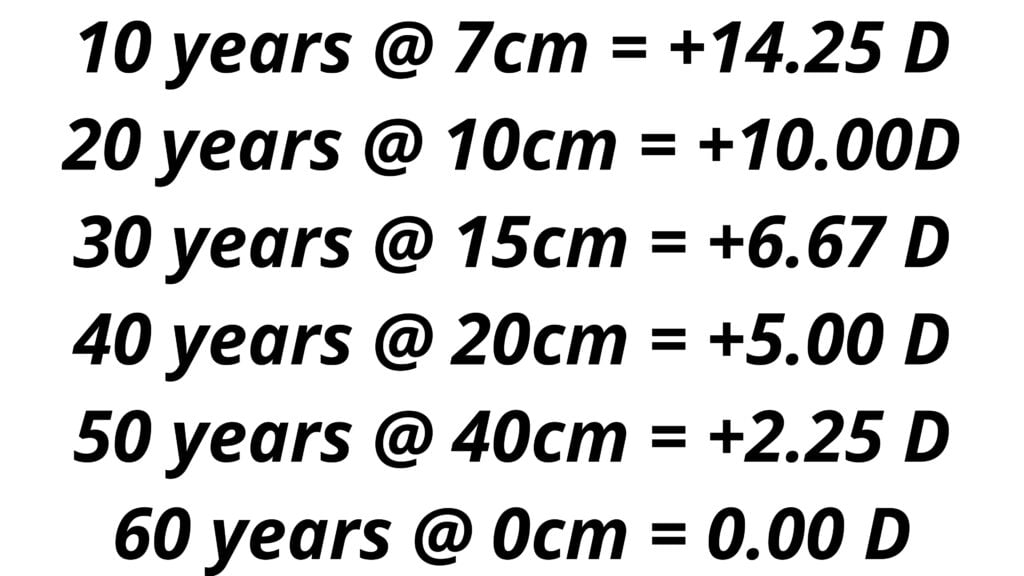
Remember: Amplitude numbers represent the maximal breaking point of focus, and can not be considered anywhere near a comfortable realm of focusing.
How many Diopters Can an Eye Accommodate (Focus) Comfortably?
The World Council of Optometry suggests limiting children’s work distances to beyond 12” (30cm) due to an observation of increased myopia potentially associated with near work distances. Thirty centimeters converts to +3.33 D of focus of maximal focus for a child.
For fifty-year-old-plus people who want to read comfortably at 16” (40cm), even though they may be able to focus +2.25D for split moment in ideal settings, they would prefer to focus a maximum of zero to +0.50 diopters for durational reading.
Therefore, a comfortable range of focus for a corrected eye ranges between 0.00 D through +3.25 D, depending upon age, vision limitations, and personal comfort.
Why Does Accommodation (Focus) Get Worse Over 40 years old?
The crystalline lens that sits behind the pupil in the eye changes shape to allow for accommodative changes in vision. This shape change occurs because the ciliary muscles that surround the lens contract. The lens changes shape due to its built in natural elastic properties. However, after the age of forty, the elastic properties naturally taper away. By about 50-53 years old, the amount of work required to focus the lens for any extended period of time becomes nearly impossible for the ciliary muscles. This hardening of the lens that occurs in everybody across the world is called, “presbyopia”.
Are Focus and Accommodation the Same Thing?
Though “accommodation” is often used interchangeably with the term “focus”, focus can also be used to describe the entire “Accommodation Reflex”. Therefore, using the term “focus” can sometimes create confusion. For example, if Robin Hood is slinging arrows in a tournament, he will focus on the target to understand distance and location. In this example, he is not simply altering the accommodation of his eyes, he is relying more upon the function of vergence to support binocularity and the resultant parallax created to aid his depth perception to gauge his aim and distance.
What is the Accommodation Reflex?
The Accommodation Reflex is a mechanism of sight that the brain uses to combine accommodation with vergence and pupillary responses for quick and coordinated responses in vision. When fully visually corrected in the real world, we can look from far-to-near and near-to-far with binocularity and without experiencing noticeable “lag” in our vision because our brain manages this ocular combination so precisely. Accommodation and vergence both must input more work when an object looms, and then both must relax as an object recedes. Since the nature of light does not change in the real world, they work nearly flawlessly as an example of superb natural coordination of working and relaxing together.
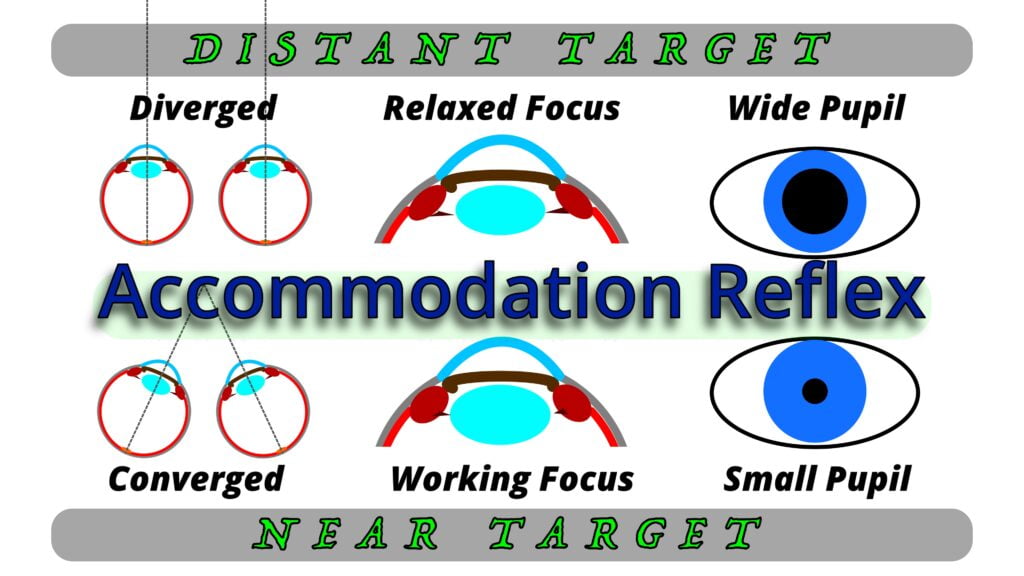
Can there be Problems with the Accommodation Reflex?
Yes, there are many problems that can exist with the accommodation reflex. Disruptions to the extra-ocular, iris, or ciliary muscles, refractive error, neural wiring, systemic conditions, medications, or the brain trauma are a few complications that can dissociate the accommodation reflex. Changes in the lens that occurs over time, as with presbyopia, also disrupts the accommodative reflex. Given that there are many conditions that can disrupt it, many diseases can be also found by evaluating the accommodative reflex for any atypical dissociation.
How Can Refractive Error Create Accommodation Reflex Problems?
A common condition that occurs to people who have uncorrected hyperopia (farsightedness) is esotropia (crossed-eyes). To understand why, first understand that within the accommodation reflex, the brain automatically recognizes that the closer that objects get to the eyes, the more the eyes must accommodate, and the more the eyes must converge as well. That is the nature of the accommodation reflex… to keep this combination of focusing functions in simple harmony. However, when a person has uncorrected hyperopia, the eye must accommodate more than normal, even for things far away. So, for example, when hyperopic eyes are trying to keep the vergence lines of sight parallel to maintain fixation, but the accommodation system is saying, “Hey brain, we’re focusing here,” the accommodation reflex will create a disruptive inward vergence response to coordinate with the accommodation, causing the lines of sight to cross. Since the eyes are trying to view a distant object instead, however, only one eye’s line of sight will remain fixated on the target, and the other will cross. This is called “refractive esotropia.” Therefore, the simple resolution to this sort of esotropia is corrective lenses to relieve the extra accommodative demand from the uncorrected hyperopia, and allow the accommodative reflex elements to work as designed, in synchrony.
What is the Vergence-Accommodation Conflict?
In current Virtual Reality (VR) systems, images are created by two separate displays (one in front of each eye) that provide parallax between the two eyes that is similar to the real world experience. As objects move in VR, the vergence of our eyes coordinate in a very similar manner as they would in the real world. This careful alignment of images for vergence is what allows for depth perception and the overall immersion into the virtual world experience.
However, unlike the finely tuned vergence aspect of vision within VR, accommodation demand is nothing like the real world experience. Instead of continuous effort from the ciliary muscles to fine tune the focus of the lens as fixation distances change, accommodation is set at one distance in most VR systems today. So, when objects appear to come closer and move further away, our accommodative demand does NOT change. Instead, accommodation remains at that one predetermined distance, usually between 1 to 2 meters, depending upon the virtual system being used. A range of 1-2 meters (100-200 cm) translates to a focal plane from +0.50 Diopters to +1.00 Diopters (averaging at about +0.75D).
Since vergence is represented in the virtual world similarly to the real world, but accommodation in the virtual world is nothing like the real world, the two systems do not mesh well in VR. This lack of meshing is termed “Vergence-Accommodation Conflict”. Simply put, the brain’s accommodation reflex is disrupted. The effect can be one of many factors that can make you “motion sick” while you are immersed in the virtual world.

Any recommendations to Alleviate the Vergence-Accommodation Conflict?
I have two suggestions to limit the Vergence-Accommodation Conflict. The first suggestion is to wear your best optical correction (in spectacle glasses or soft contact lenses). Wearing the best correction will offset any “extra” focus required by your own visual system. For example, if you think you are seeing well, but you are actually a +1.00 diopter hyperope (you have to work +1.00 D even when your eye is supposed to be relaxed when viewing in the distance), then to view in virtual reality, your accommodation requirement will be additive: +1.00D & +0.75D = +1.75D. Comparing your experience in VR to another user who is optically corrected will likely yield an increase in headset use discomfort due to the added focal demand.
My second suggestion to limit Vergence-Accommodation Conflict is to allow time for adaptation. Even though the accommodation and vergence systems do not coordinate in the VR world and can prove physiologically uncomfortable, it doesn’t mean that the brain can not adapt to the new setting. In fact, given enough experience with VR, the alternate visual demands will become less noticeable to the point that it does not cause any disruptions. Our brains are smart. With experience (meaning continued exposure), our brain’s can adapt to the virtual world so that the “motion sickness” goes away.
Can Contact Lenses be worn in Virtual Reality?
Clear Soft Contact Lenses can be worn as visual correction in all virtual reality to date, but Cosmetic Soft Lenses (colored lenses), Rigid Gas Permeable Lenses, and Scleral Lenses can pose a problem for the eye tracking in VR systems; such as with the Apple Vision Pro. Contact lenses can save from the cost of purchasing Optical Inserts for VR and decrease the discomfort of wearing spectacle glasses (when allowed) under the headset. The main drawback of soft lenses when using VR is the increased tendency (much like computer use) of the contact lens and eye becoming more dry. When we are immersed in a visual experience, we tend not to blink as much as we should (we try to see as much as we can, so our blink rate reduces), and this limits the natural balance of tears through our eyes, allowing for tear breakup and, ultimately, dry eye. It may sound silly, but the simple answer to this problem is “Make sure to keep blinking while you are in VR.” Other good advice is to take breaks every so often to give your eyes time to reset after a drying experience.
How Do I get Soft Contact Lenses for my Virtual Reality System?
To get soft contact lenses, first you need to get an eye exam from a licensed eye doctor. A proper fit with a compatible and healthy contact lens for your needs must be determined. Therefore, go to an eye doctor who will actually look at your eye directly and determine your eye’s current health condition, and stay away from online entities that do not see you in person.
Once your contact lens Rx is determined, your doctor will give you a complete copy of your contact lens Rx (whether you ask for it or not, it is FDA regulated that they give you a copy of your contact lens script physically or electronically). Then, go to DeliverContacts.com for the TOP BRAND soft contact lenses, at ALWAYS LOW prices, with FREE DELIVERY, and the BEST CUSTOMER SERVICE. Again, that is DeliverContacts.com (I happen to be the owner of DeliverContacts.com by the way… just so you know).
Can the Vergence-Accommodation Conflict be Corrected?
To reduce the vergence-accommodation conflict in virtual reality, different designs are currently being explored. Some designs include Varifocal lenses, Multifocal Lenses, and Light Field Displays.
What is the Varifocal Design in Virtual Reality?
The Varifocal design in Virtual Reality headsets attempt to mimic the real world experience for accommodation, to get rid of the Vergence-Accommodation Conflict. Various designs are being produced, but the ultimate goal is to create a smooth and speedy accommodative transition as the eye goes back and forth from far and near. To achieve the eye’s standard of efficiency, very high level eye tracking systems must be employed.
What is the Multifocal Design in Virtual Reality?
The Multifocal designs in Virtual Reality headsets attempt to create a more comfortable accommodative experience by utilizing multiple planes of focus at various depths instead of just one, to limit the effect of the Vergence-Accommodation Conflict. These designs can have any number of planes, and do not require an eye tracking system because each of the planes remain static. This isn’t a perfect system of focus, but is expected to mimic the real world more comfortably than the single plane design.
What are Light Field Displays in Virtual Reality?
Light Field Displays in Virtual Reality headsets is a developing design hoping to mimic the real world experience of accommodation’s natural association with vergence, but without the need for eye tracking like the varifocal lens designs require. Instead, it requires high level control of light projection patterns that would render a much more natural flow of the accommodation reflex, and hopefully eliminate the vergence-accommodation conflict altogether.
Is the Vergence-Accommodation Conflict Harmful to the Eyes?
No, the Vergence-Accommodation Conflict is not harmful to the eyes. Disruptive… yes. Harmful… no. The experience of the dissociated systems of vergence and accommodation can be disruptive enough to make a virtual reality user “seasick,” but discomfort does not equal harm to the eye or the brain. The brain is actually smart enough to adapt to the dissociation with continued experience, without the user even being aware that the brain is processing the data. The brain can adapt to the point where the “seasick feeling” may even go away entirely.
Newer designs and system innovations (such as with optics, resolution, lag, and distortions) are expected to allow adaptation to the vergence-accommodation conflict to be much easier. This easing of adaption will occur because its not just the vergence-accommodation conflict that is responsible for VR discomfort issues, but there are also multiple other imperfections within virtual reality experience that cumulatively create adaptation complications. So, even if the vergence-accommodation conflict effect is not eliminated, improvement in other aspects of virtual reality are expected to minimize its effect.
Need Consistanly Cheap Contacts?
DeliverContacts.com always guarantees you are paying low prices, every time you buy. We will never play games with our pricing or take part in manipulative discounts. Just consistently cheap contacts, forever.
Give your box a search below and see for yourself! 100% Free shipping and returns on all products!
